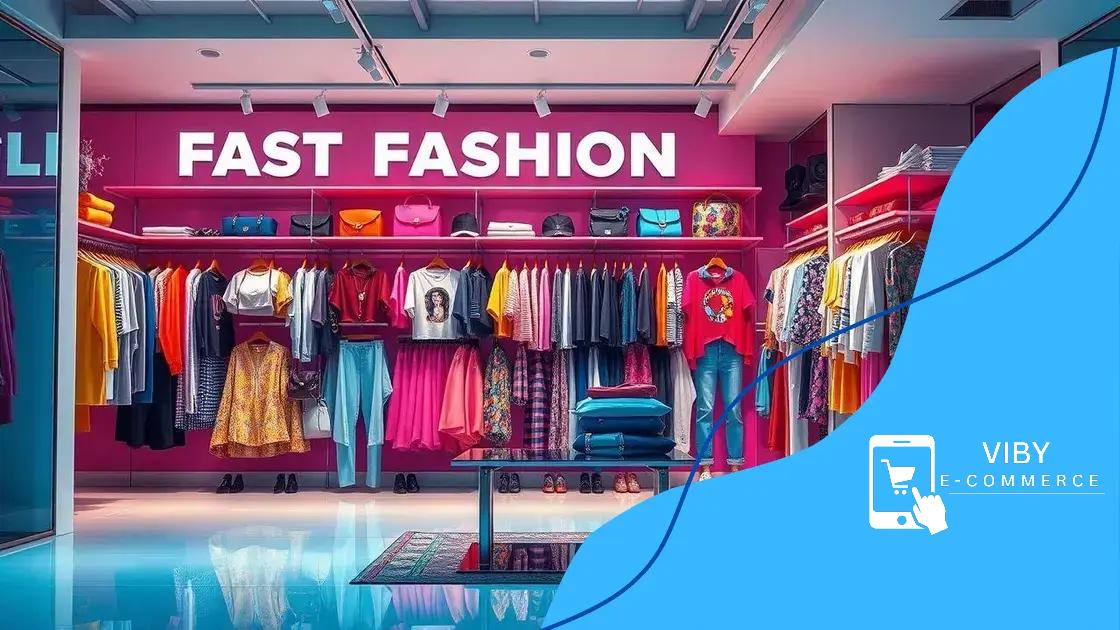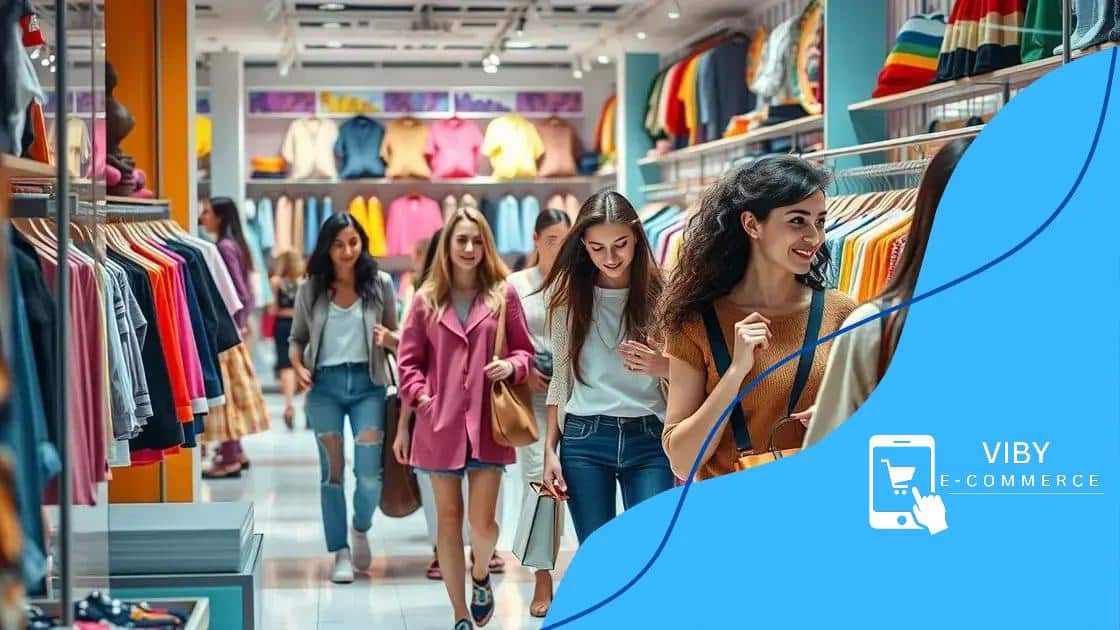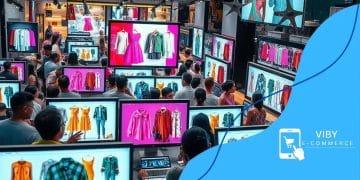How Shein is reshaping the fast fashion landscape

How Shein is reshaping the fast fashion landscape involves rapid production, low prices, social media engagement, and a growing focus on sustainability amid evolving consumer preferences.
How Shein is reshaping the fast fashion landscape has become a conversation starter in the fashion industry. Ever wondered what makes this brand so influential? Let’s delve into its unique approach.
Understanding Shein’s business model
Understanding Shein’s business model is key to grasping its success in the fast fashion industry. This brand leverages various strategies that allow it to thrive in a highly competitive market.
Fast Fashion and Shein
Shein’s approach revolves around fast fashion, a concept that entails rapidly producing trendy clothing based on current market demands. This enables Shein to bring new designs to consumers in as little as a few weeks.
Key Elements of Shein’s Model
Several attributes define Shein’s unique business model:
- Data-Driven Decisions: Shein utilizes customer data to inform its designs and inventory.
- Affordable Pricing: By maintaining low production costs, Shein offers trendy items at prices accessible to a broad audience.
- Agility: Quick response to fashion trends allows Shein to stay relevant and appealing to its customer base.
Additionally, Shein heavily invests in digital marketing, with strong social media presence and influencer collaborations. This approach not only drives sales but also enhances brand visibility.
Another crucial aspect of Shein’s business model is its expansive online platform, where shoppers can browse a vast array of products. This digital-first approach caters to the preferences of today’s consumers, who favor online shopping.
Consumer Engagement
Shein fosters a sense of community among its users through innovative marketing tactics. The brand encourages its customers to share their outfits on social media, creating a buzz around its products.
In essence, by embracing a fast-paced production cycle, incorporating data analytics, and engaging with consumers uniquely, Shein effectively reshapes the landscape of fashion retail.
The impact of Shein on sustainability
The impact of Shein on sustainability is a topic of intense discussion today. As a major player in the fast fashion industry, its practices raise important questions about environmental responsibility and ethical production.
Sustainability Challenges
Shein’s rapid production cycle leads to significant waste, combining low-cost manufacturing with high consumer demand. The brand’s model encourages a constant turnover of clothing, which can result in:
- Increased textile waste in landfills.
- High levels of carbon emissions from shipping products.
- Overuse of resources, such as water and energy.
Many critics argue that these practices contradict sustainable goals. For instance, the swift lifecycle of clothing can lead to a culture of disposability, where items are worn only a few times and then discarded. Yet, Shein is aware of these criticisms and has started to implement some sustainable measures.
Steps Towards Sustainability
In response to the growing concern, Shein has initiated various efforts aimed at improving its sustainability footprint. Some of these steps include:
- Launching a program to recycle clothing.
- Introducing eco-friendly materials into their product lines.
- Engaging in partnerships with sustainability organizations.
While these efforts highlight some progress, the scale and efficacy of these initiatives are still under scrutiny. The reality is, for substantial impact, Shein needs to further transform its production and operational approaches to prioritize sustainability.
Moreover, consumers are becoming increasingly aware of the environmental implications of their purchases. This shift in mindset often leads to demand for brands to prioritize eco-friendly practices, which can influence companies like Shein to make more necessary changes.
Consumer behaviors in the fast fashion era

Consumer behaviors in the fast fashion era are evolving rapidly. With platforms like Shein gaining popularity, shoppers are now prioritizing speed and affordability over quality.
Shifting Preferences
Today’s consumers often prefer the latest trends, which leads to a demand for a constant flow of new items. This results in:
- A greater emphasis on impulse buying.
- A desire for low-cost, trendy clothing.
- Less concern for long-term garment durability.
As a result, many people have adopted a mindset of viewing clothing as disposable. This change is primarily driven by the accessibility of fast fashion brands that provide trendy styles at lower prices.
Social Media Influence
Social media also plays a crucial role in shaping consumer behaviors. Platforms like Instagram and TikTok showcase trends instantly and can ignite a viral demand for specific outfits. As influencers wear and promote these brands, their followers are influenced to make quick purchases.
Additionally, online reviews and user-generated content create a sense of community. Consumers feel empowered to share their experiences, which in turn influences others to join the fast fashion cycle.
Environmental Awareness
Interestingly, while many consumers are drawn to affordability and style, there is a growing awareness about the environmental impact of fast fashion. Shoppers are slowly starting to consider sustainability but may still prioritize price and trend.
Some consumers are now seeking brands with ethical practices despite the previous focus on low cost. This duality in consumer behavior creates a complex landscape for companies like Shein.
How Shein utilizes social media
How Shein utilizes social media is a vital part of its marketing strategy. The brand leverages various platforms to connect with consumers, promote products, and drive sales.
Engagement with Influencers
One key method is through collaboration with influencers. Shein partners with social media stars who showcase its products to their followers. This creates an immediate desire for the latest trends. Popular influencer campaigns often lead to:
- Increased brand visibility.
- Higher engagement rates.
- A boost in sales through promotional codes.
By allowing influencers to model their clothes, Shein taps into their dedicated fan bases, making the brand more relatable to potential customers.
Targeted Advertising
Shein also utilizes targeted ads on platforms like Facebook and Instagram. These ads are tailored to specific demographics, ensuring that potential customers see products that match their interests and shopping behaviors.
This approach increases the likelihood of conversion, as ads are relevant to users. Shapes of advertising campaigns include eye-catching graphics and short videos that highlight new arrivals or seasonal collections.
User-Generated Content
Moreover, Shein encourages user-generated content by prompting customers to share photos wearing their purchases. This strategy not only builds community but also serves as authentic marketing. Customers see real people enjoying the brand, which boosts trust and encourages others to shop.
Social media challenges and hashtags further engage audiences, inviting them to participate by showcasing their own styles. This interaction creates a vibrant online community focused on fashion.
Future trends in fast fashion
Future trends in fast fashion are shaping the industry in new and unexpected ways. As consumer preferences evolve, brands must adapt to maintain relevance.
Increased Focus on Sustainability
One major trend is the push for sustainability. With more consumers becoming environmentally aware, brands are expected to implement greener practices. This means:
- Using eco-friendly materials
- Reducing waste through recycling initiatives
- Implementing ethical labor practices
Fast fashion brands, including Shein, are starting to explore these options to meet consumer demand for sustainable fashion.
Technology and Digital Innovation
Another trend is the growing role of technology. Innovations such as AI and machine learning are transforming how brands operate. These technologies can forecast trends, automate production, and enhance customer experiences. For example, brands can analyze consumer data to tailor their offerings more precisely.
Moreover, augmented reality (AR) is becoming popular in online shopping. It allows customers to try on clothes digitally, providing a unique shopping experience that can boost sales.
Shift Towards Personalization
Personalization will also play a significant role in the future of fast fashion. Shoppers want options that reflect their individual styles. As a result, brands may offer more custom items and tailored recommendations based on previous purchases.
This shift towards personalization not only enhances customer satisfaction but can also increase brand loyalty. The ability to engage customers on a personal level can drive repeat purchases.
Finally, as fast fashion continues to evolve, brands must remain agile. The landscape is constantly changing, and staying ahead of trends is crucial for success.
FAQ – Frequently Asked Questions about Shein and Fast Fashion
What is Shein’s main business model?
Shein primarily focuses on fast fashion, rapidly producing trendy clothing at low prices based on current consumer demands.
How does Shein impact sustainability in the fashion industry?
While Shein provides affordable fashion, it faces criticism for environmental concerns due to waste and resource overuse, prompting some sustainable initiatives.
What role does social media play in Shein’s marketing strategy?
Shein utilizes social media by partnering with influencers, running targeted ads, and encouraging user-generated content to engage customers and drive sales.
What are some future trends expected in fast fashion?
Future trends include increased sustainability efforts, technological innovations like AI, and a greater focus on consumer personalization in shopping experiences.





